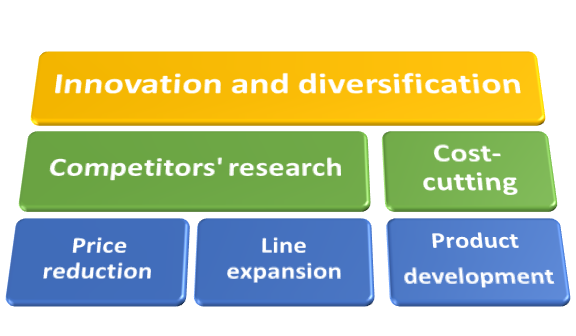What is market saturation?
Market saturation occurs when a marketplace's volume of service or product has reached its maximum capacity. In this circumstance, the only way for a company to thrive is to improve its products by acquiring market share from competitors or boosting consumer demand.
Summary
- When the volume of an item or service in a specific market reaches its maximum, the market is said to be saturated.
- Firms design products that wear out over time and need to be replaced to help combat market saturation.
- Unique marketing techniques, effective pricing, and inventiveness can help businesses deal with market saturation.
Frequently Asked Questions (FAQs)
What are the causes of saturation in the market?
Market saturation arises when a product's market growth trajectory remains unchanged, implying that the supply of the product exceeds its demand.
On a micro level, this frequently happens when a company faces intense competition or the market's demand for its service or product has decreased. For example, in a town, there might be three ice cream parlours within a two-block radius.
Market saturation also refers to the moment in a product's life cycle when the product or service has been made widely available to consumers to the point where any fresh product idea will be rejected. After then, a company cannot earn an additional market share in the same market, for the same product, without diminishing the market share of another company.
The revenue growth rate of a company tends upward from its inception, and companies can spend two to three decades in the growth phase. However, the upward trend eventually stops, and the revenue growth rate begins to decline.
The aggregate volume of all enterprises in a market will reach a point where all prospective consumers of a specific product are served during the duration of an industry's lifecycle. A natural limit is formed when an industry exploits a universe of regular users to its utmost extent. Even population growth slows when countries progress and modernise, resulting in decreased fertility rates.
Simply put, market saturation happens when a company's whole client base has been served, and no new customer acquisition opportunities are accessible on a macro level.
Because of market saturation, many businesses have been forced to change their business models, especially when product demand begins to wane. When the vast computer server market became saturated, IBM, for example, had to shift its business model to provide recurring services.

Source:© Jirsak | Megapixl.com
What are the strategies for avoiding market saturation?
Companies might use various tactics to delay or avoid the market saturation phase of a product's life cycle. The following are some of them:
Price reduction
Because clients are price-sensitive, businesses operating in a saturated market might sell their items for less to win market share. As a result, businesses engage in price wars with one another, consistently underselling to entice people to purchase products.
Amazon, for example, is well-known for employing a price-cutting tactic to drive competitors out of the market. However, it is not a long-term strategy because it impacts the company's profitability, and demand is limited. Likewise, the unprofitability of several unicorn firms, such as Uber Eats and Grub Hub, can be ascribed to their persistently low prices.
Competitors' research
Researching competitors is critical; understanding the strategies that competitors use to advertise their businesses can provide you with an advantage when your consumer base is small.
In addition, by paying attention to the techniques others in your industry utilise, you can figure out what would work best for your firm to deal with the market saturation and learn from their failures.
Besides, research may provide you with an idea for an entirely new business plan that would differentiate your service or product.

Source:© Jirsak | Megapixl.com
Cost-cutting
When a firm's profits are stagnant, sometimes it resorts to cost-cutting methods. While cutting unneeded or avoidable costs may be helpful, the technique fails to address the source of the problem. The leading cause of lower profits is a drop in income.
Furthermore, cost-cutting has a limit, and once reached, the company would have to rely on revenue for long-term profitability. As a result, supply-side remedies will not be able to solve demand-side issues.
Line expansion
Companies might try to combat stagnant income by using geographical line expansion of the same product. The line expansion marketing approach has proven to boost demand, but most companies have already exceeded the line expansion's boundaries leading to increased globalisation.
Fast-food chains, such as McDonald's, have expanded significantly both worldwide and domestically. Furthermore, while the overall market size remains the same, the line expansion strategy frequently results in cannibalism.
Innovation and diversification
Diversification is thought to be the most successful method for combating market saturation since it helps businesses broaden their potential client base by entering neighbouring areas. As a result, the businesses generate new demand, consumer value, and revenue streams.
To improve demand, an effective diversification strategy should focus on innovations. As a result, the goal should be to provide value to customers rather than provide more services and products. Companies in developed countries can expand into emerging markets.
Development of a product
Companies sometimes manufacture some of their goods to wear out quickly to increase sales through repeat purchases from customers. Companies, for example, design mobile phone chargers and headphones with less durable structures, leaving users with little another choice but to purchase the product repeatedly.

Source: Kalkine Media
What are the benefits of a saturated market?
- In this phase, there will be an entirely new product on the market.
- It aids in the correction of existing goods and services prices produced by businesses. For example, companies might offer premium-based alternative methods or low-cost providers of a product or service with detailed pricing.
- This supports firms in coming up with fresh ideas for new services and goods to sell.
- Companies can use various marketing methods to set themselves apart from their competitors' products and stay competitive.
What are the drawbacks of a saturated market?
- Firms are forced to change their business models to stay afloat.
- Companies must modify old products and produce new ones to avoid market saturation, which is only feasible after a great deal of effort.
- Companies must invest in a field of business that requires a significant capital investment to create and innovate new goods and services.
 Please wait processing your request...
Please wait processing your request...